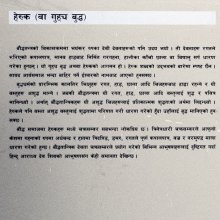Drishtigata, Dṛṣṭigata, Drishti-gata: 5 definitions
Introduction:
Drishtigata means something in Buddhism, Pali, Hinduism, Sanskrit. If you want to know the exact meaning, history, etymology or English translation of this term then check out the descriptions on this page. Add your comment or reference to a book if you want to contribute to this summary article.
The Sanskrit term Dṛṣṭigata can be transliterated into English as Drstigata or Drishtigata, using the IAST transliteration scheme (?).
Images (photo gallery)
In Buddhism
Mahayana (major branch of Buddhism)
Source: academia.edu: A Study and Translation of the GaganagañjaparipṛcchāDṛṣṭigata (दृष्टिगत) refers to “doctrinal viewpoints”, according to the Gaganagañjaparipṛcchā: the eighth chapter of the Mahāsaṃnipāta (a collection of Mahāyāna Buddhist Sūtras).—Accordingly, “How then, son of good family, does the Bodhisattva never lose his supernormal knowledge after having attained the mastery of all dharmas? Son of good family, if a certain ascetic or a Brahmin produces the supernormal knowledge without having overcome the view that there is a permanent substance, he will loose his supernormal knowledge. However the Bodhisattva, having overcome sixty-two doctrinal viewpoints (dvāṣaṣṭi-dṛṣṭigata) derived from the root view that there is a permanent substance, produces the supernormal knowledge in the absence of any attachment of view; [...]”.

Mahayana (महायान, mahāyāna) is a major branch of Buddhism focusing on the path of a Bodhisattva (spiritual aspirants/ enlightened beings). Extant literature is vast and primarely composed in the Sanskrit language. There are many sūtras of which some of the earliest are the various Prajñāpāramitā sūtras.
Languages of India and abroad
Sanskrit dictionary
Source: DDSA: The practical Sanskrit-English dictionaryDṛṣṭigata (दृष्टिगत).—a theory, doctrine.
Derivable forms: dṛṣṭigatam (दृष्टिगतम्).
Dṛṣṭigata is a Sanskrit compound consisting of the terms dṛṣṭi and gata (गत).
Source: Cologne Digital Sanskrit Dictionaries: Edgerton Buddhist Hybrid Sanskrit DictionaryDṛṣṭigata (दृष्टिगत).—(also dṛṣṭī°, sometimes even in prose; = Pali diṭṭhigata), nt., rarely masc., lit. what relates to heresy, substantially = dṛṣṭi, heresy; compare in Majjhimanikāya (Pali) commentary i.71.20 diṭṭhi yeva diṭṭhigataṃ, gūthagataṃ (text gutha°) viya; compare also dṛṣṭi-kṛta, which is not recorded in Pali or elsewhere; and see s.v. gata: Mahāvyutpatti 4651; Kāśyapa Parivarta 18.8; 109.2, see dṛṣṭi-kṛta (Tibetan renderings noted there); pāpakāni akuśalāni dṛṣṭigatāky utpannāni Lalitavistara 398.3 = Mahāvastu iii.317.7; dṛṣṭigatāni Lalitavistara 398.10; Jātakamālā 146.7; Bodhisattvabhūmi 228.1; °gatam Śikṣāsamuccaya 61.19; other, misc. forms Mahāvastu iii.67.9; 353.15 (°gateṣu, mss., Senart °gatiṣu); Śikṣāsamuccaya 18.4; Kāśyapa Parivarta 154.9; Gaṇḍavyūha 117.3; 508.15; dṛṣṭī-gatāni Mahāvastu iii.318.14 (prose: v.l. dṛṣṭi°); °gataṃ Suvarṇabhāsottamasūtra 61.13 (verse, ī may be m.c.); other dṛṣṭīgata, in prose, Kāśyapa Parivarta 94.3; 95.4; masc. dṛṣṭigatān Divyāvadāna 164.19, 22; dṛṣṭigatan (m.c. for °tān, °tāny) Kāśyapa Parivarta 18.8 (verse).
Source: Cologne Digital Sanskrit Dictionaries: Monier-Williams Sanskrit-English DictionaryDṛṣṭigata (दृष्टिगत):—[=dṛṣṭi-gata] [from dṛṣṭi > dṛś] n. theory, doctrine, [Divyāvadāna 164.]
Sanskrit, also spelled संस्कृतम् (saṃskṛtam), is an ancient language of India commonly seen as the grandmother of the Indo-European language family (even English!). Closely allied with Prakrit and Pali, Sanskrit is more exhaustive in both grammar and terms and has the most extensive collection of literature in the world, greatly surpassing its sister-languages Greek and Latin.
Nepali dictionary
Source: unoes: Nepali-English DictionaryDṛṣṭigata (दृष्टिगत):—adj. seen; visible;
Nepali is the primary language of the Nepalese people counting almost 20 million native speakers. The country of Nepal is situated in the Himalaya mountain range to the north of India.
See also (Relevant definitions)
Partial matches: Drishti, Gata.
Full-text: Gata, Krita, Dalana, Drishtikrita, Dvashashti, Gambhiradharma, Kanda, Drishti.
Relevant text
Search found 2 books and stories containing Drishtigata, Dṛṣṭigata, Drishti-gata, Dṛṣṭi-gata, Drstigata, Drsti-gata; (plurals include: Drishtigatas, Dṛṣṭigatas, gatas, Drstigatas). You can also click to the full overview containing English textual excerpts. Below are direct links for the most relevant articles:
Maha Prajnaparamita Sastra (by Gelongma Karma Migme Chödrön)
Bodhisattva quality 28: excelled in destroying various wrong views < [Chapter XIII - The Buddha-fields]
Bodhisattva quality 10: patience relating to the profound dharmas < [Chapter X - The Qualities of the Bodhisattvas]
Part 3 - Patience in regard to the Buddhadharma < [Chapter XXV - Patience Toward the Dharma]
Sushruta Samhita, Volume 6: Uttara-tantra (by Kaviraj Kunja Lal Bhishagratna)
Chapter VII - Pathology of the diseases of the Pupil < [Canto I - Shalakya-tantra (ears, eyes, nose, mouth and throat)]
Chapter XVIII - Preparations and medicinal measures for ocular affections in general < [Canto I - Shalakya-tantra (ears, eyes, nose, mouth and throat)]
Chapter XVII - Treatment of diseases of pupil and crystalline lens < [Canto I - Shalakya-tantra (ears, eyes, nose, mouth and throat)]
